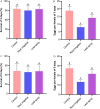Endophytic Beauveria bassiana of Tomato Resisted the Damage from Whitefly Bemisia tabaci by Mediating the Accumulation of Plant-Specialized Metabolites
- PMID: 37646319
- PMCID: PMC10510379
- DOI: 10.1021/acs.jafc.3c03679
Endophytic Beauveria bassiana of Tomato Resisted the Damage from Whitefly Bemisia tabaci by Mediating the Accumulation of Plant-Specialized Metabolites
Abstract
Beauveria bassiana acts as an endophytic fungus that controls herbivorous pests by stimulating plant defenses and inducing systemic resistance. Through multiomics analysis, 325 differential metabolites and 1739 differential expressed genes were observed in tomatoes treated with B. bassiana by root irrigation; meanwhile, 152 differential metabolites and 1002 differential genes were observed in tomatoes treated by local leaf spraying. Among the upregulated metabolites were α-solanine, 5-O-caffeoylshikimic acid, clerodendrin A, and peucedanin, which demonstrated anti-insect activity. These differential metabolites were primarily associated with alkaloid biosynthesis, flavonoid biosynthesis, and tryptophan metabolism pathways. Furthermore, the gene silencing of UDP-glucose:sterol glucosyltransferase, a gene involved in α-solanine synthesis, indicated that B. bassiana could inhibit the reproduction of whiteflies by regulating α-solanine. This study highlighted the ability of B. bassiana to modulate plant secondary metabolites and emphasized the significance of understanding and harnessing multitrophic interactions of endophytic B. bassiana for sustainable agriculture.
Keywords: Beauveria bassiana; Bemisia tabaci; metabolomic; plant secondary metabolites; tomato; transcriptomic.
Conflict of interest statement
The authors declare no competing financial interest.
Figures







References
-
- Jaber L. R.; Ownley B. H. Can we use entomopathogenic fungi as endophytes for dual biological control of insect pests and plant pathogens?. Biol. Control 2018, 116, 36–45. 10.1016/j.biocontrol.2017.01.018. - DOI
-
- Gupta R.; Keppanan R.; Leibman-Markus M.; Rav-David D.; Elad Y.; Ment D.; Bar M. The entomopathogenic fungi Metarhizium brunneum and Beauveria bassiana promote systemic immunity and confer resistance to a broad range of pests and pathogens in tomato. Phytopathology 2022, 112, 784–793. 10.1094/PHYTO-08-21-0343-R. - DOI - PubMed
-
- De Meyer G.; Bigirimana J.; Elad Y.; Höfte M. Induced systemic resistance in Trichoderma harzianum T39 biocontrol of Botrytis cinerea Geert. Eur. J. Plant Pathol. 1998, 104, 279–286. 10.1023/A:1008628806616. - DOI
MeSH terms
LinkOut - more resources
Full Text Sources

